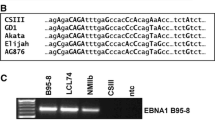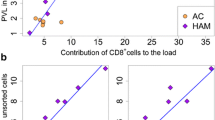Abstract
All T lymphocytes and some B lymphocytes express CD5. This coreceptor is encoded by one gene that consists of 11 exons. We have previously described a B cell-specific alternative exon 1, leading to the synthesis of a protein, devoid of leader peptide, and, therefore, retained in the cytoplasm. The novel exon 1 originates from a human endogenous retrovirus (HERV) at a time interval between the divergence of New World monkeys from Old World monkeys, and prior to the divergence of humans from Old World monkeys. Based on sequence similarity to γ-retroviruses, it was categorized as class I: based on the specificity of its primer binding site, it was allotted to the subclass E, and based on its location within the cd5 gene, named HERV-E.CD5. Alternative transcripts were detected in lymphoid organs including fetal liver (not adult liver), more particularly in CD5-negative cell surface B-1b than in CD5-positive cell surface B-1a, and not at all in B-2 cells. By alignment of 5′ long terminal repeats, HERV-E.CD5 was distinguished from similar proviruses. This could be central to the regulation of membrane expression of CD5 in human B lymphocytes, and, thereby, to the strength of the B-cell antigen receptor signaling.







Similar content being viewed by others
References
Padilla O, Calvo J, Vila JM et al. Genomic organization of the human CD5 gene. Immunogenetics 2000; 51: 993–1001.
Calvo J, Sole J, Simarro M, Vives J, Lozano F . Evolutionarily conserved transcription regulatory elements within the 5′-flanking region of the human CD5 gene. Tissue Antigens 1996; 47: 257–261.
Youinou P, Jamin C, Lydyard PM . CD5 expression in human B-cell populations. Immunol Today 1999; 20: 312–313.
Kasaian MT, Ikematsu H, Casali P . Identification and analysis of a novel human surface CD5-B lymphocyte subset producing natural antibodies. J Immunol 1992; 148: 2690–2702.
Renaudineau Y, Hillion S, Saraux A, Mageed RA, Youinou P . An alternative exon 1 of the CD5 gene regulate CD5 expression in human B lymphocytes. Blood 2005, DOI 10.1182/blood-2005-02-0597.
Bannert N, Kurth R . Retroelements and the human genome: new perspectives on an old relation. Proc Natl Acad Sci USA 2004; 101 (Suppl 2): 14572–14579.
Li WH, Tanimura M . The molecular clock runs more slowly in man than in apes and monkeys. Nature 1987; 326: 93–96.
Bauer VW, Squire TL, Lowe ME, Andrews MT . Expression of a chimeric retroviral-lipase mRNA confers enhanced lipolysis in hibernating mammal. Am J Physiol Integrative Comp Physiol 2001; 281: R1192–R2001.
Landry JR, Rouhi A, Medstrand P, Mager DL . The Opitz syndrome gene Mid1 is transcribed from a human endogenous retroviral promoter. Mol Biol Evol 2002; 19: 1934–1942.
Schulte AM, Lai S, Kurtz A, Czubayko F, Riegel AT, Wellstein A . Human trophoblast and choriocarcinoma expression of the growth factor pleiotrophin attributable to germ-line insertion of an endogenous retrovirus. Proc Natl Acad Sci USA 1996; 93: 14759–14764.
Repaske R, Steele PE, O'Neill RR, Rabson AB, Martin MA . Nucleotide sequence of a full-length retroviral segment. J Virol 1985; 54: 764–772.
Medstrand P, Mager DL . Human specific integrations of the HERV-K. J Virol 1998; 72: 9782–9787.
Medstrand P, Landry JR, Mager DL . Long terminal repeats are used as alternative promoters for the endothelin B receptor and apolipoprotein C-I genes in humans. J Biol Chem 2001; 276: 1896–1903.
Hardy RR, Hayakawa K . CD5 B cells, a fetal B cell lineage. Adv Immunol 1994; 55: 297–339.
Page SL, Goodman M . Catarrhine phylogeny: noncoding DNA evidence for a diphyletic origin of the mangabeys and for a human-chimpanzee clade. Mol Phylogenet Evol 2001; 18: 14–25.
Bergsagel PL, Timblin CR, Eckhardt L, Laskov R, Kuehl WM . Sequence and expression of a murine cDNA encoding PC326, a novel gene expressed in plasmacytomas but not normal plasma cells. Oncogene 1992; 7: 2059–2064.
Benoist C, Mathis D . Autoimmune diabetes. Retrovirus as trigger, precipitator or marker? Nature 1997; 338: 833–834.
Perron H, Jouvin-Marche E, Michel M et al. Multiple sclerosis retrovirus particles and recombinant envelope trigger an abnormal immune response in vitro, by inducing polyclonal Vβ16 T-lymphocyte activation. Virology 2001; 287: 321–322.
Sen G, Bikah G, Venkataraman C, Bondada S . Negative regulation of antigen receptor-mediated signalling by constitutive association of CD5 with the SHP-1 protein tyrosine phosphatase in B-1 cells. Eur J Immunol 1999; 29: 3319–3328.
Lorincz MC, Schubeler D, Groudine M . Methylation-mediated proviral silencing is associated with MeCP2 recruitment and localized histone H3 deacetylation. Mol Cell Biol 2001; 21: 7313–7322.
Nakao M . Epigenics: interaction of DNA methylation and chromatin. Gene 2001; 31: 25–31.
Ogasawara H, Okada M, Kaneko H, Hishikawa T, Sekigawa I, Hashimoto H . Possible role of DNA hypomethylation in the induction of SLE: relationship to the transcription of human endogenous retroviruses. Clin Exp Rheumatol 2003; 21: 733–738.
Gotzinger N, Sauter M, Roemer K, Mueller-Lantzsch N . Regulation of human endogenous retrovirus-K gag expression in teratocarcinoma cell lines and human tumours. J Gen Virol 1996; 77: 2983–2990.
Altschul SF, Gish W, Miller W, Myers EW, Lipman DJ . Basic local alignment search tool. J Mol Biol 1990; 215: 403–410.
Nicholas KB, Nicholas Jr HB, Deerfield II DW . GeneDoc: analysis and visualization of genetic variation. EMBNEW News 1997; 4: 1–4.
Saitou N, Nei M . The neighbor-joining methods: a new method for reconstructing phylogenetic trees. Mol Biol Evol 1987; 4: 406–425.
Felsenstein J . PHYLIP: phylogeny inference package (Version 3.2). Cladistics 1989; 5: 164–166.
Kimura M . A simple method for estimating evolutionary rates of base substitutions through imperative studies of nucleotide sequences. J Mol Evol 1980; 16: 111–120.
Schulte AM, Wellstein A . Structure and phylogenetic analysis of an endogenous retrovirus inserted into the human growth factor gene pleiotrophin. J Virol 1998; 12: 6065–6072.
Acknowledgements
We thank S Forest and C Séné for secretarial assistance.
Author information
Authors and Affiliations
Corresponding author
Additional information
Financial interests: none
Rights and permissions
About this article
Cite this article
Renaudineau, Y., Vallet, S., Le Dantec, C. et al. Characterization of the human CD5 endogenous retrovirus-E in B lymphocytes. Genes Immun 6, 663–671 (2005). https://doi.org/10.1038/sj.gene.6364253
Received:
Revised:
Accepted:
Published:
Issue Date:
DOI: https://doi.org/10.1038/sj.gene.6364253
- Springer Nature Limited
Keywords
This article is cited by
-
Immunophenotyping As a New Tool for Classification and Monitoring of Systemic Autoimmune Diseases
Clinical Reviews in Allergy & Immunology (2017)
-
Types of DNA methylation status of the interspersed repetitive sequences for LINE-1, Alu, HERV-E and HERV-K in the neutrophils from systemic lupus erythematosus patients and healthy controls
Journal of Human Genetics (2014)
-
Autoreactive B Cells and Epigenetics
Clinical Reviews in Allergy & Immunology (2010)




